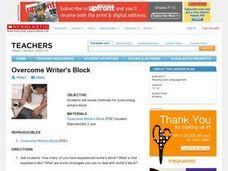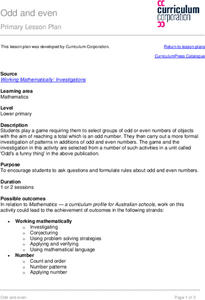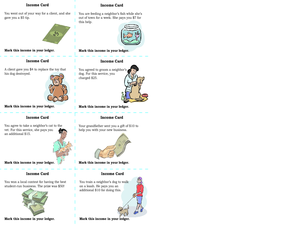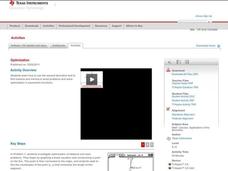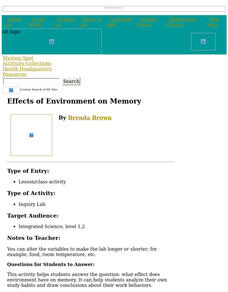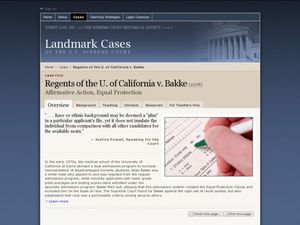Curated OER
The Crucible
Students participate in a layered curriculum unit. Credit is earned for learning, which comes about through listening, discussion, reading, and/or doing. They are verbally assessed for each activity chosen to complete.
Curated OER
What I Didn't Know...
Young scholars practice creating wikis. In this wiki lesson, students create a wiki about any math topic that they know nothing about. Young scholars learn about their topic and create a wiki that explains the math topic in detail.
Curated OER
Various Roles of Musicians
Students research and collect information about a musician that they are interested in. They then incorporate their information into a PowerPoint presentation which includes pictures and audio files, and share their slide show with the...
Curated OER
Writing and Scholarship Planning For College-Bound Students: Overcome Writer's Block
Learners examine methods for overcoming writer's block. They complete a worksheet, write personal statements, and participate in a class discussion.
Curated OER
What is Sound?
Second graders discuss sound and describe them. In this investigative instructional activity students observe sound through their eyes, bodies and ears.
Curated OER
Creating a Found Poem
Teach your English learners about theme through this found poem project. Class members read two versions of O. Henry's "The Gift of the Magi": the original version and a synopsis. After learning about themes and connecting theme to their...
Curated OER
History of Natural Resources in the U.S.
Young scholars define conservation, exploitation and preservation, identify legislation related to conservation and environmental issues, and identify leaders and organizations that were key to the conservation and environmental movements.
Curated OER
Odd and even
Learners play a game requiring them to select groups of odd or even numbers of objects with the aim of reaching a total which is an odd number. They carry out a more formal investigation of patterns in additions of odd and even numbers.
Curated OER
Two-Step Problems and Money Concepts
Elementary schoolers solve two-step equations and practice money concepts. They solve multi-step addition and subtraction contextual problems and apply money concepts to real life situations. Pupils use pictures and counters to help them...
Curated OER
Pop-it...Stop-it
Students observe how certain geometric shapes can be used to make some structures rigid and others flexible. The activity involves construction of a 30-60 right triangle, folding while following directions, and identifying polygons.
Curated OER
Schools Closings: What Are the Guidelines?
Pupils gather and read articles about school closures in Ohio or other nearby town or city, make list of criteria to use when deciding which schools should close, develop list into essay that argues for these criteria to apply in school...
Curated OER
Income and Expenses
Students discuss income and expenses. In this lesson plan on money, students define income and expenses, after whith they keep track of their income and expense transactions on a basic ledger.
Curated OER
How Can You Tell One Clear Gas From Another?
Fifth graders perform experiments to determine the identity of an unknown gas sample. In this chemistry activity, 5th graders fill balloons with air, oxygen, hydrogen, and carbon dioxide. They use mass and reactivity to identify the gases.
Curated OER
World War I
Eighth graders examine the condition of the world from 1880 until the start of World War I. After watching a PowerPoint presentation, they discuss the causes and effects of the war and complete a study guide with a partner. To end the...
Curated OER
Optimization
Learners identify the critical points to a function. In this calculus lesson plan, students perform optimization of functions. They use the TI to create a visual of the graph.
Curated OER
What Does Dna Look Like?
Students build DNA strands and practice base pairing rules using an interactive website in this technology-based lesson for a high school science class. This lesson includes links to the interactive website, a worksheet, and a video...
Curated OER
Alternative Energy
Students discover types of energy. In this physics lesson, students discuss ways to power a car a design a model car kit with an alternative form of energy.
Curated OER
Effects of Environment on Memory
High schoolers explore the effect that environment has on memory. They analyze their own study habits and draw conclusions about their work behaviors. Baseline capacity is established for the subjects' ability to memorize an increasing...
Curated OER
Student Designed Investigations: Observations
Students choose an organism and create an experiment with that organism. In this observation lesson, students expose a living thing to something from its environment and record their observations. Students must have some prior knowledge...
Curated OER
Moh's Scale of Hardness
Students investigate how to use Moh's Hardness Scale. In this geology lesson, students examine several minerals and develop a hypothesis about which mineral is the hardest. Students use the Moh's Scale Identification Chart to determine...
Curated OER
For the Birds
Second graders explore biology by creating birdhouses. In this bird identification lesson, 2nd graders discuss the different types of birds that live in their environment and what characteristics each type of bird has. Students create a...
Curated OER
What Do Plants Need?
Students experiment with plants. In this plant lesson plan, students research the needs of plants. Students determine if all plants have the same requirements for growth. In small groups, students experiment with different plants.
Curated OER
Regents of the U. of California v. Blake
Students examine affirmative action and equal protection. In this Supreme Court lesson plan, students examine primary documents from Regents of the U. of California v. Blake and discuss the implications of the decision.
Curated OER
Estamos en la granja (We are on the farm)
Learners receive a blank farm scene and a baggie of animal cutouts with names on them. They sit back to back so they cannot see each other's farm scene, then place 3-4 animals on their farm scene. They ask each other if their animal is...



